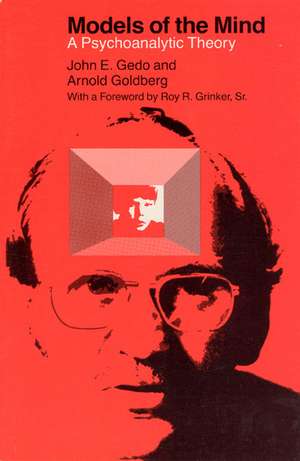Models of the Mind: A Psychoanalytic Theory
Autor John E. Gedo, Arnold Goldbergen Limba Engleză Paperback – 31 aug 1976
In an effort to expand the clinical theory of psychoanalysis, John E. Gedo and Arnold Goldberg delineate and order the various generally accepted systems of psychological functioning, considered here as "models of the mind." The authors provide a historical review of four major models of the mind: the topographic model, the reflex arc model, the tripartite model, and an object relations model. They then investigate the possible hierarchical interrelationships of such models. Each model is shown to represent a different facet of mental functioning and is thus employable on an ad hoc basis. The models are shown not to cancel on another out but to allow for theoretical complementarity.
Gedo and Goldberg apply their theory to four classic psychoanalytic case studies to demonstrate its effectiveness: Freud's Rat Man, his Wolf Man, the case of Daniel Paul Schreber, and a case of arrested development. For each of these cases the authors show how it would have been both possible and advantageous to apply a variety of different theories as facts about each continued to accumulate.
Gedo and Goldberg apply their theory to four classic psychoanalytic case studies to demonstrate its effectiveness: Freud's Rat Man, his Wolf Man, the case of Daniel Paul Schreber, and a case of arrested development. For each of these cases the authors show how it would have been both possible and advantageous to apply a variety of different theories as facts about each continued to accumulate.
Preț: 262.43 lei
Nou
Puncte Express: 394
Preț estimativ în valută:
50.21€ • 52.43$ • 41.56£
50.21€ • 52.43$ • 41.56£
Carte tipărită la comandă
Livrare economică 04-18 aprilie
Preluare comenzi: 021 569.72.76
Specificații
ISBN-13: 9780226284873
ISBN-10: 0226284875
Pagini: 236
Dimensiuni: 140 x 216 x 15 mm
Greutate: 0.27 kg
Ediția:Revised
Editura: University of Chicago Press
Colecția University of Chicago Press
ISBN-10: 0226284875
Pagini: 236
Dimensiuni: 140 x 216 x 15 mm
Greutate: 0.27 kg
Ediția:Revised
Editura: University of Chicago Press
Colecția University of Chicago Press
Notă biografică
John E. Gedo is past president of the Chicago Psychoanalytic Society. Arnold Goldberg is professor of psychiatry at Rush Medical College.
Cuprins
Foreword by Roy R. Grinker, Sr.
Acknowledgments
I. Introduction and Historical Review
1. The Problem: Current Clinical Theory in Psychoanalysis
2. Freud's Clinical Theory of 1900: The Topographic Model
3. Freud's Clinical Theory of 1923: The Tripartite Model
4. Freud's Conceptualization of the Unstructured Psyche: The Model of the Reflex Arc
5. On the Unformulated Segment of Psychoanalytic Theory: The Emerging Psychology of the Self
II. The Hierarchical Model
6. Developmental Lines in Interaction
7. The Hierarchy of Modes of Psychic Functioning
8. A Demonstration of the Clinical Utilization of the Hierarchical Model
9. Applications of the Hierarchical Model
10. Further Applications of the Hierarchical Model
III. Conclusions and Implications
11. A Psychoanalytic Nosology and Its Implications for Treatment
12. Conclusions and Implications for Psychoanalytic Theory
Notes
Bibliography
Index
Acknowledgments
I. Introduction and Historical Review
1. The Problem: Current Clinical Theory in Psychoanalysis
2. Freud's Clinical Theory of 1900: The Topographic Model
3. Freud's Clinical Theory of 1923: The Tripartite Model
4. Freud's Conceptualization of the Unstructured Psyche: The Model of the Reflex Arc
5. On the Unformulated Segment of Psychoanalytic Theory: The Emerging Psychology of the Self
II. The Hierarchical Model
6. Developmental Lines in Interaction
7. The Hierarchy of Modes of Psychic Functioning
8. A Demonstration of the Clinical Utilization of the Hierarchical Model
9. Applications of the Hierarchical Model
10. Further Applications of the Hierarchical Model
III. Conclusions and Implications
11. A Psychoanalytic Nosology and Its Implications for Treatment
12. Conclusions and Implications for Psychoanalytic Theory
Notes
Bibliography
Index
